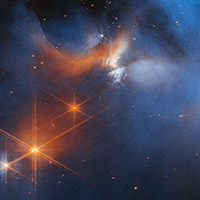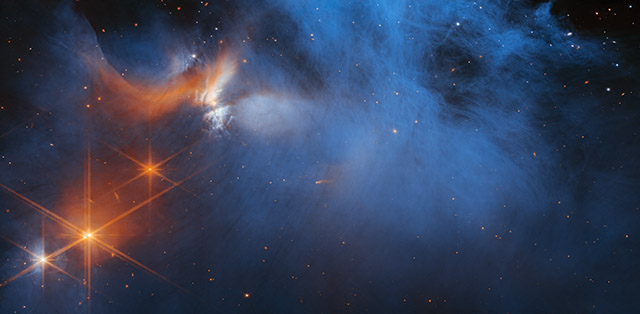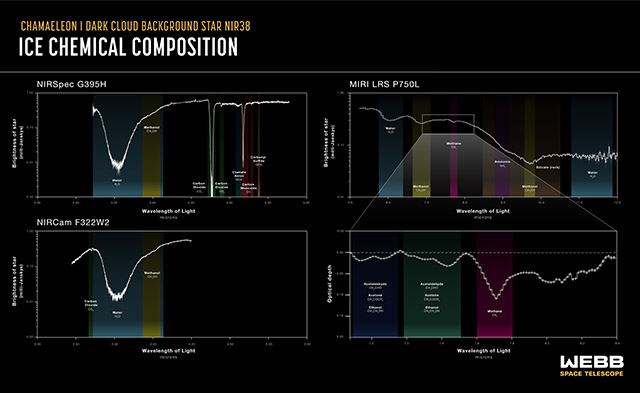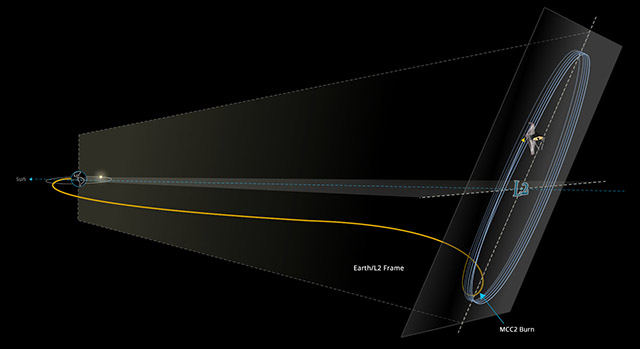James Webb Space Telescope investigates molecular cloud & studies pre-stellar ice chemistry
posted Tuesday, January 24, 2023 at 2:00 PM EDT

The James Webb Space Telescope has identified frozen forms of a range of molecules using its NIRCam instrument. A team of astronomers has created an inventory of some of the deepest, coldest ices ever measured in a molecular cloud. The team identified simple ices, like water, alongside molecules including carbonyl sulfide, ammonia, methane and methanol. The Webb Telescope team writes, "This is the most comprehensive census to date of the icy ingredients available to make future generations of stars and planets, before they are heated during the formation of young stars."
These observed icy molecules may be simple, or in the case of methanol, complex organic molecules now, but they may one day comprise stars and exoplanets. Some of the molecules are the essential building blocks of life. Ices are vital for new planets, as they include key elements like carbon, hydrogen, oxygen, nitrogen and sulfur.
"Our results provide insights into the initial, dark chemistry stage of the formation of ice on the interstellar dust grains that will grow into the centimeter-sized pebbles from which planets form in disks," said Melissa McClure, an astronomer at Leiden Observatory in the Netherlands. "These observations open a new window on the formation pathways for the simple and complex molecules that are needed to make the building blocks of life." McClure is the lead author of a newly-published research paper outlining the study's results.

Credits: Image: NASA, ESA, CSA / Science: Fengwu Sun (Steward Observatory), Zak Smith (The Open University), IceAge ERS Team / Image processing: M. Zamani (ESA/Webb)
Beyond the molecules the team identified, they also found evidence of molecules more complex than methanol. While they can't definitely attribute the observed signals to specific molecules, it's the first evidence that proves that complex molecules do, in fact, form in icy molecular clouds before stars are born. Will Rocha, an astronomer at Leiden Observatory and contributor to the study, said, "Our identification of complex organic molecules, like methanol and potentially ethanol, also suggests that many star and planetary systems developing in this particular cloud will inherit molecules in a fairly advanced chemical state. This could mean that the presence of precursors to prebiotic molecules in planetary systems is a common result of star formation, rather than a unique feature of our own solar system."
The researchers were able to estimate the amount of sulfur in the observed icy, pre-stellar dust grains for the first time. However, the amount was less than the amount expected based on the cloud's density. Where additional sulfur, and other molecules, may be hiding is a key challenge for astronomers. Molecules and elements may be hiding in other ices, soot-like materials or rocks. McClure added that some of these building blocks of exoplanets and atmospheres might be locked up in materials that the team can't measure.
Speaking of measurement, how does Webb determine the quantity of different molecules in deep space ice? The chemical characterization is performed by studying how starlight beyond the observed molecular cloud is absorbed by the icy molecules within the cloud at specific infrared wavelengths. You can measure chemical fingerprints left behind, known as absorption lines, and compare them against laboratory data to identify which ices must be present in the molecular cloud.

Credits: Illustration: NASA, ESA, CSA, Joseph Olmsted (STScI) / Science: Klaus Pontoppidan (STScI), Nicolas M. Crouzet (LEI), Zak Smith (The Open University), Melissa McClure (Leiden Observatory)
The targeted molecular cloud is within a particularly cold and dense region of the Chamaeleon I molecular cloud. The region is about 630 light-years from Earth and is in the process of forming "dozens of young stars." Klaus Pontoppidan, a Webb project scientist at the Space Telescope Science Institute in Baltimore, said, "We simply couldn't have observed these ices without Webb. The ices show up as dips against a continuum of background starlight. In regions that are this cold and dense, much of the light from the background star is blocked, and Webb’s exquisite sensitivity was necessary to detect the starlight and therefore identify the ices in the molecular cloud."
There's much more to come from McClure and the rest of the team. "This is just the first in a series of spectral snapshots that we will obtain to see how the ices evolve from their initial synthesis to the comet-forming regions of protoplanetary disks," said McClure. "This will tell us which mixture of ices — and therefore which elements — can eventually be delivered to the surfaces of terrestrial exoplanets or incorporated into the atmospheres of giant gas or ice planets."
The amazing ice study isn't the only Webb news lately. Today, NASA announced that Webb has performed its final postlaunch course correction and has reached its final orbit around the second Sun-Earth Lagrange point (L2), nearly a million miles from Earth. The final mid-course burn added only 3.6 miles per hour (1.6 meters per second) to Webb's speed – a human walking pace. Webb's orbit at L2 will "allow it a wide view of the cosmos at any given moment, as well as the opportunity for its telescope optics and scientific instruments to get cold enough to function and perform optimal science."
